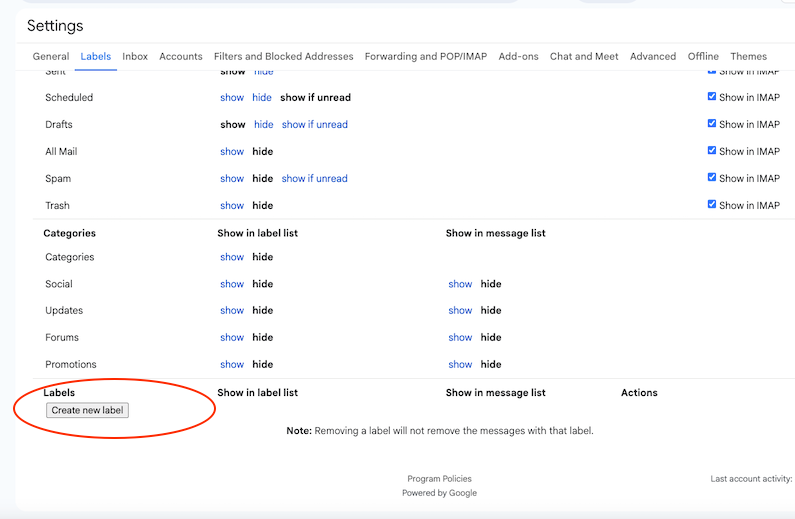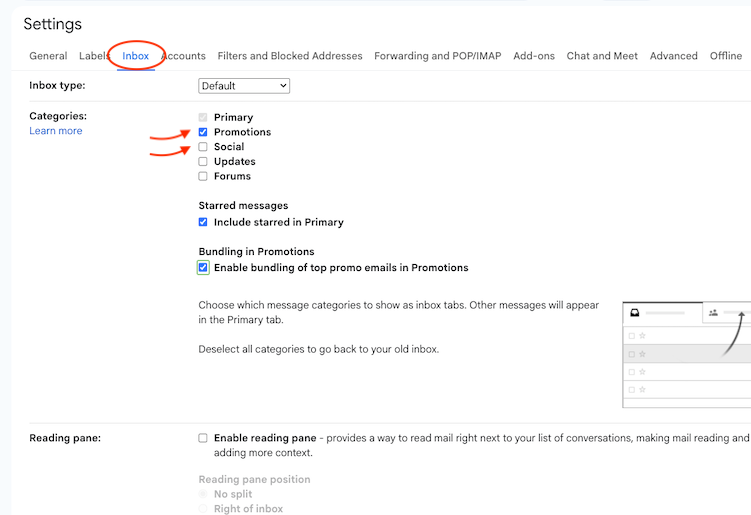Whether you’re figuring out how to clear email inbox clutter, organize your folders, or automate everyday messages, the right system can turn your inbox from overwhelming to effortless. With a few smart strategies, you’ll reclaim hours each week and finally have space to focus on the work that actually moves your business forward.
Ready to make email work for you, not against you? Let’s explore how to choose the best email platform and build systems that keep you organized, focused, and in control.
Find the right solution for your business
Answer a few quick questions to get started:
Choose the Right Email Platform for Your Business
If you don’t already have a business email, start by creating one. Most popular email providers offer business accounts, and setting up a custom address (like hi@yourbusinessname.com) usually costs less than $10 per month.
There’s no need to stress about this choice. You’re likely already using an email platform for communication, so you can stick with what you’re familiar with.
Google Workspace
Google Workspace (formerly G Suite) is one of the most popular options for small to medium businesses, and it integrates with all the other tools in Google Workspace, such as Google Docs, Google Calendar, Google Sheets, and more.
Microsoft 365
Microsoft 365 is another popular option, best suited for businesses already using the Microsoft ecosystem, as it offers integration with Word, Excel, PowerPoint, and Teams.
Zoho Mail
Small businesses like Zoho Mail because it offers increased privacy and is also significantly cheaper than competitors.
Set Up Your Stress-Free Inbox System: A Step-By-Step Guide
Now that you’ve chosen your email platform, it’s time to get your inbox organized.
Inbox Zero or Not: Decide What Works Best For You
Before diving into organization strategies, let’s address your overall inbox philosophy. There are two main approaches you could take.
The Inbox Zero Approach: This method was popularized by productivity expert Merlin Mann, and refers to keeping your inbox empty at all times. That means every email you receive is processed: deleted, archived, delegated or turned into a task once you receive it.
Inbox Zero works well if you:
Feel stressed when you see unread emails piling up
Have the discipline to process emails immediately
Want to ensure nothing falls through the cracks
Handle a moderate volume of emails (under 50 per day)
For some people, achieving Inbox Zero brings a sense of calm before they start their day. For others, just the idea of it feels stressful. If that’s you, don’t worry; you can stay organized without ever hitting Inbox Zero.
If you’re thinking, “That sounds great, but my inbox has thousands of emails, there’s no way this will work,” don’t worry. Create a folder called “Old Emails” and move all the emails into it. From there, you can start fresh with an empty inbox. Congrats, you’ve hit reset!
The "Inbox as a To-Do List" Approach: This method treats your inbox like a task list. Emails stay in your inbox until they're completely resolved. Important emails remain visible, serving as reminders of tasks that require attention.
This approach works well if you:
Use your inbox as a visual reminder system
Handle high email volumes that make immediate processing unrealistic
Prefer having context readily available
Often need to reference email threads while working
Set Up Folders and Labels
A simple way to start organizing your inbox is by labeling your emails and sorting them into folders. For example, you might have one for Clients, another for Accounting, and one more for Urgent messages.
Some examples of labeling systems include:
Action required: Emails that need immediate attention
Waiting for: Items you're expecting responses on
Projects: Organize by current business projects
Archive: Completed items you might need to reference
Color coding in Gmail or Outlook will make visual scanning faster. You can choose red for urgent, yellow for follow-up, and green for completed or go with your own system.

Image: Create new labels in Gmail by going to “Settings” and navigating to “Labels”.
Automate with Smart Filters and Rules
Here are some examples of automation rules you can set up in your inbox to reduce the number of emails coming into your inbox:
Route newsletters and promotional emails to a "Reading" folder
Automatically label shipping notifications from FedEx, UPS or USPS into a folder
Flag emails containing keywords like "urgent" or "invoice"
Forward certain types of emails to team members

Image: In Gmail, under “Settings” and then “Inbox” you can set up different categories for e-mail such as promotions, so they are not all in one place.
Here’s an example of a filter and a rule you can create:
From: "ship-notify@amazon.com" OR Contains "fedex.com" OR "ups.com"
Action: Move to "Shipping" folder + Apply "Deliveries" label
Subject contains: "Your order" OR "Shipment" OR "Tracking"
Action: Apply "Orders" label + Move to "Purchases" folder
Use Productivity Approaches To Streamline Your Inbox
Email is distracting. It’s easy to fall into the trap of responding right away, only to trigger another response, which will require you to respond, forever! Before you know it, you’ve sent 100 emails, but made no real progress.
What’s more, response time expectations are only shrinking. According to a 2024 study by Deloitte, before the pandemic, the average response time for emails was four hours. In 2024, it was two hours.
That same study also found that employees spend an average of 28% of their day on emails, which is often unplanned and reactionary. That’s time you could be spending on your actual business!
Here are some of the most common productivity approaches you can use to reduce the amount of unnecessary back-and-forth emails and make the most of the time you do spend in your inbox.
Use the Two-Minute Rule For Your Inbox
This rule says, if an email takes less than two minutes to address, do it immediately. If it takes longer, either:
Schedule dedicated time to handle it
Delegate it to someone else
Move it to your "Action Required" folder with a clear next step
Use Email Signature to Provide Helpful Information
Your email signature is valuable real estate that can give people information they are likely looking for and manage expectations about when you’ll respond. Email signatures provide basic information about where people can learn more about you, such as:
Your name and title
Company website
Social media links
A headshot (optional, but it gives people more context)
A brief call-to-action or company tagline
(optional) expectations for when you will respond
Here’s an example:
Sarah Johnson
Business Growth Consultant
www.growthconsulting.com
I typically respond within 24 hours on business days
Ready to scale your business? Book a free 30-minute discovery call
Have questions? Check our FAQ: www.growthconsulting.com/faq
Use Templates for Common Responses
Once you’re in business for a while, you’ll find that there are the same emails you keep writing. Emails like sales follow-ups, customer onboarding, and frequently asked questions. When you find you’re writing the same email for the fifth time, it’s time to create a template.
Most email platforms allow you to save these as templates or canned responses.
Establish Email Batching Habits
Raise your hand if you keep your inbox open all day and immediately see new emails come in. This is common, but it doesn’t help your productivity at all.
Instead of checking email constantly throughout the day, try these tips instead:
Set specific times for email, such as 9 AM, 1 PM, 4 PM
Turn off non-essential notifications
Use "Do Not Disturb" modes during focused work time
Batch similar tasks together (all client emails, all vendor communications)
Consider Setting Up An Auto-Reply
Depending on the nature of your business and how many emails you actually receive, you may want to set up an auto-reply. If you’re at a point where your team can’t monitor all emails personally, but you want to acknowledge all the emails you receive, or you’re receiving a high volume of emails with the same type of inquiry, an auto-reply is a good idea.
General auto-replies can:
Confirm receipt of inquiries
List frequent next steps clients are likely reaching out about (such as a link to schedule an intro call)
Set expectations for response times
Links to FAQs or resources for common questions
Direct people to your website for immediate answers
Establish a Regular Maintenance System
Once you have the basics covered, you’ll want to set up a maintenance system.
Weekly email maintenance:
Make sure emails are organized and labeled correctly
Archive completed items
Review and update auto-reply messages
Clean out promotional folders
Review and adjust email rules
Monthly email hygiene:
Unsubscribe from unnecessary lists
Review storage usage and archive old emails
Update email signatures and templates
Assess what's working and what needs adjustment
Long-Term: Integrate Emails With Project and Task Management
If you’re using project management tools for your business, you can further streamline your systems by integrating your email with other parts of your business. Here are some examples:
Forward emails to Asana, Trello, or Monday.com
Use Zapier to automate workflows between email and other apps
Turn emails into calendar events automatically
Setting Up Your Inbox Correctly is a Long-Term Investment in Your Business
Think about a well-organized email system as an investment in the longevity of your business. Setting up systems that work for you will take some time up front, but in the long term, you’ll be saving so much time. Start by choosing an email platform if you don’t have one already. Then, commit to one or two organizational strategies and gradually build from there as you gain more confidence with your systems.
The best systems are the ones you use, so there’s no need to revamp your inbox overnight completely, but rather spend time choosing the methods that fit your work style and adjust as your business evolves.


